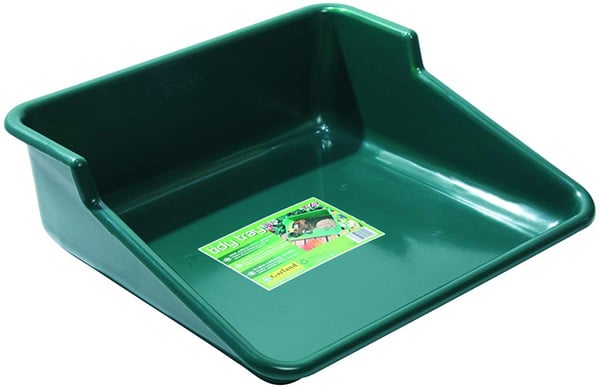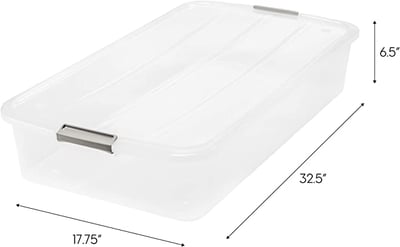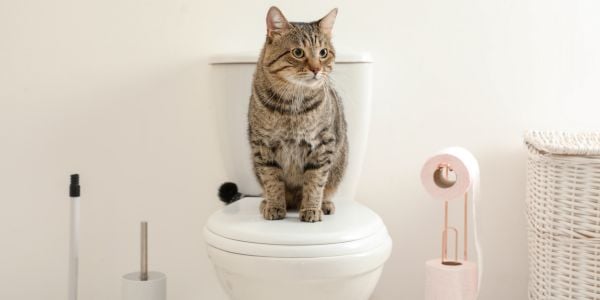
Your cat’s litter box may seem like an inconvenience.
Let’s face it: they’re one of the less pleasant things about having a cat.
But the litter box is actually hugely important.
The wrong litter box can lead to a variety of issues, from stress to fighting between cats and even house soiling.
Let’s talk about what your cat needs from their litter box.
Key Takeaways (TL/DR)
1. The Wrong Litter Box Can Cause Behavior Issues: Ensure your cat's litter box meets their natural, instinctual needs, including size and sightlines. See which poor litter box types and features cause behavior issues
2. Covered Boxes Are Not Ideal for Cats: They can cause stress if your cat can't see who's outside that box stalking them, like your playful new kitten. And they hold in the stink, which we like, but our cats don't. Find out all the reasons why enclosed boxes aren't good
3. Automatic Cleaning Boxes Are Not a Great Idea: They're small and covered, and they move, which can easily startle your cat and encourage them to head in the other direction when it's time to pee. Learn why
4. Just Because Your Cat "Likes" Their Litter Box Now, It Doesn't Mean They Always Will: If something changes in your cat's world, it could lower their tolerance for using a litter box that hasn't been meeting their needs well. Something could suddenly become "the straw that broke the camel's back"
5. The Ideal Litter Box Is the Right Size and Height: The size depends on how long your cat is and if they have mobility restrictions. Find out the ideal measurements, product picks that are long enough, and learn how to DIY a custom litter box
6. Litter Boxes Will Need to Be Replaced As They Get Scratched Up: Scratches in the plastic harbor bacteria and smell. Find out how often you should replace your cat's litter boxes and how to clean them well
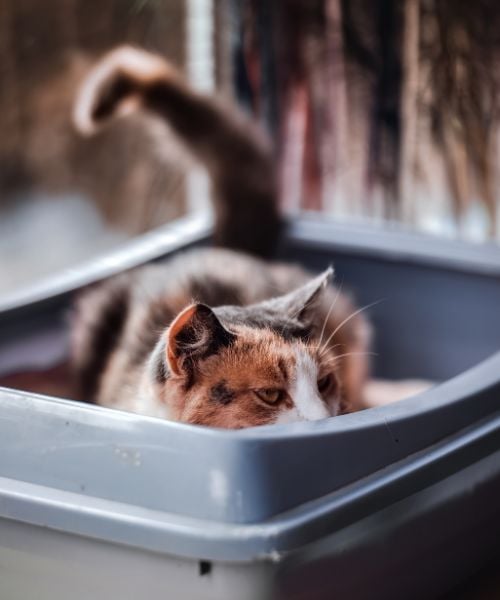
Cat Behavior Issues Caused by the Wrong Litter Box
You might be surprised to hear all the things that can come up for your cat(s) if they aren’t feeling good about their litter box setup. We talk all about things like litter type, location, and number of boxes in our Litter Box Setup article. Today, we’re looking at the litter box itself.
A word of advice: if you're thinking of toilet training your cat – don't do it!!! It's a completely unnatural experience and body posture for a cat. And it's something a senior cat or one with mobility issues won't be able to do, which will cause issues down the road.
Why Does Your Cat Care About the Box?
It’s just a place to get in, do their business, and get out, right? Wrong.
Cats haven't been formally domesticated — we didn’t breed out any of their natural characteristics when we let them in to live with us. That means our housecats are pretty much the same as their wild ancestors. They have the same needs, instincts, and reactions to things. That’s why the litter box matters.
The litter box needs to fit those natural needs and instincts, or it seems like a less-than-ideal place to eliminate. And if they aren’t peeing and pooping in the box, they’re doing it somewhere else.
About half of my behavior consult clients are dealing with house soiling. I suggest litter box adjustments to 99% of them. Sometimes, that’s all it takes. Other times, it’s much more complex. But even for other issues, like cats not getting along or cats dealing with high stress and anxiety, litter box changes are often recommended. It’s that important – not just to resolve issues but to keep new issues from starting.
Issues Your Cat May Experience With Many of the Popular Litter Boxes on the Market
Every cat is unique, and they have their own preferences, but these are the common issues that can result from less-than-ideal litter boxes.
Issue #1: A litter box that's too small
Odds are your cat has a pre and post-litter box ritual. They get in, sniff, spin around a few times, sniff again, dig a little, spin the other way. It’s a whole thing before they actually do their business. If the box isn’t large enough to do that ritual comfortably, it’s a less-than-ideal place to eliminate. That means more potential for house soiling.
A box that’s too small can also lead to more litter being pushed out of the box, multiple cleanings each day because small boxes can fill up quickly, and peeing and pooping right over the side because your cat simply doesn’t fit.
Senior cats have a particularly hard time turning around in small boxes as they start to experience mobility and balance issues.
Urinary issues are often missed because cat owners don’t notice that their cat is peeing less. In a small box, smaller amounts of pee can pool together easily, so this important clue to a medical issue could be missed.
Ideal size for the litter box:
A good rule of thumb is that the length of the litter box should be about 1½ times the length of your cat, not including their tail. To simplify, shoot for a box that’s about as long as your cat, including most of their tail. Depending on the cat, that can be 23 inches or more.
The box should also be wide enough that your cat can turn easily. A box should be at least 13–15 inches wide, depending on the size and age of your cat.
Senior kitties may have a harder time moving and balancing, being able to step in, turn around, and step out when done is important. Otherwise, you may end up with a kitty butt hanging out the entrance of the box doing their business.
Issue #2: A litter box with a high entrance
A high-sided entrance can be an issue, especially for cats with mobility issues. Senior cats who are prone to osteoarthritis can have issues jumping into the box. Also, jumping in and out of this kind of box can lead to more litter scattered on the floor.
Most cats can jump into a low-sided box just fine. If you have a high-sided box (or make your own from a storage container, which we’ll cover below), it’s better to have a lower entrance cut in the side.
For senior or limited mobility cats, a low entrance is important. The entrance should be no more than 2 inches off the ground.
The highest of entrances are in top-access boxes, and while I cover the pitfalls of covered boxes below, these photo demonstrate to key issues with this type of entry.
First, the boxes are usually too small, so the cat has to stick their head out of the entrance while they're doing their business. Not comfortable. Then it limits their ability to dig around and cover their business. They'd have to duck under the lid and crouch while digging. It's not at all practical for the way cats instinctually eliminate.
Second, it's an invitation for other cats in the home to jump on top and loom over the cat who's using the box. This doesn't feel safe for the cat in the box so their much more likely to choose to "go" outside the box where they have escape routes.

Issue #3: Covered and enclosed boxes
A covered box, or box in an enclosure, can really be a problem. They help to contain bad smells, which is one reason people like them. But that’s a big reason cats don’t. They’re very sensitive to smells.
Pair that with the fact that they’re also generally very small, and it’s a lot like our experience in a port-a-potty, holding our breath and trying not to touch the dirty sides.
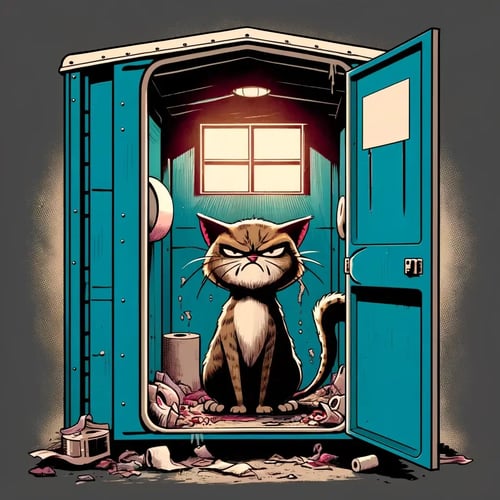
Covered boxes also keep you from seeing what’s happening in the box.
One of the first clues we get to a potential health problem is changes to litter box habits or not using the box. In fact, something like a urinary blockage can be fatal in a matter of hours.
If you can’t see that your cat is in the box trying to pee and nothing is coming out, you might miss the opportunity to catch this emergency early.
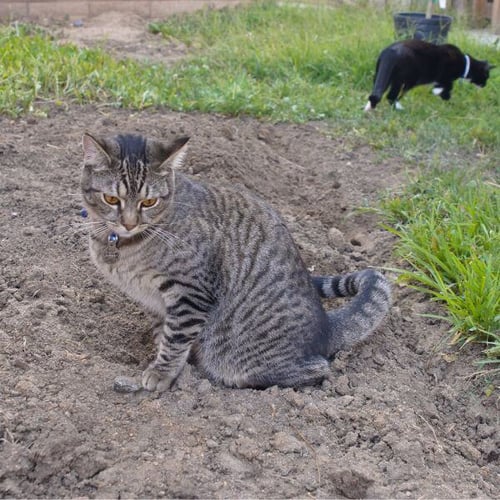
Lastly, we turn to a vital cat instinct — safety. Cats are prey animals in the wild. They’re very vulnerable when eliminating. That can be an anxious time for your cat, even when it’s happening in your home.
We might think they’d feel safer in a covered litter box, but it’s the opposite. Cats want open sightlines so they can see if anything is coming.
Especially if you have a nervous cat, cats who don’t get along well, or one cat who’s a bit play aggressive, coming out of a covered litter box is like a game of Whack-a-Mole. It can be scary. Any covered box or enclosure can cause this issue, but top entry boxes are the worst.
What your cat prefers is to have open sightlines so they can see if anything is coming. If you’re using low-sided boxes, that’s not a problem. Below, we’ll talk about how you can make it work even with very high-sided boxes.
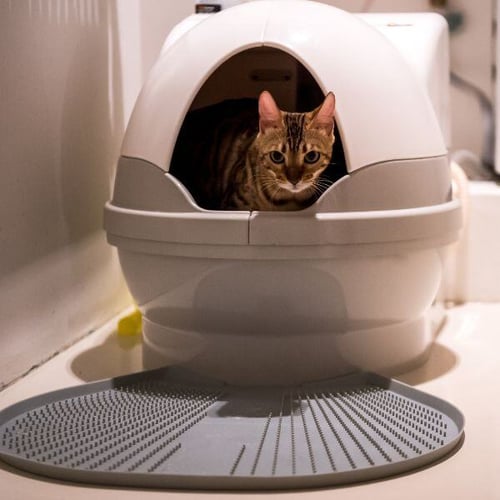
Issue #4: Automatic-cleaning litter boxes
This is where everyone hates me. Believe me, if I could recommend an automatic box, I would do so happily and use one myself. But I have to look at this from the cat’s perspective. And, unfortunately, auto-cleaning boxes can be a problem.
Many have the issues mentioned above. They’re very small. Even if the unit itself is huge, the interior area for the cat is tiny. Many are enclosed. We’ve talked about the issues that can cause. Some have entrances quite high off the ground and even come with a step. For senior cats, that step can be a problem.
I mentioned above that covered boxes are a concern because you can’t see what’s happening, and that can limit your ability to monitor your cat’s health. This is doubly true with automatic boxes. If it’s a covered version, you can’t see anything inside. You also aren’t scooping. And the bottom line is, if you’re not hands-on with what’s coming out of your cat, you’re losing a huge opportunity to track their health and catch issues early. I know the dangers of missing medical issues by not being hands-on with what’s happening in the box, and at least half of my clients are dealing with house soiling, so I see how often these boxes are a factor.
Cats are great at forming associations, good and bad.
The last big thing is that self-cleaning litter boxes have moving parts. If that box starts the cleaning process at a time that happens to scare your cat, that’s that. They make a mental note that the litter box isn’t safe and stop using it.
The price tag on these boxes can be quite high, and you’d be surprised how many house-soiling cases I’ve dealt with where replacing an automatic box was one of the biggest factors in resolving the problem.
My inclination is to suggest you avoid them because I’m looking at it from a cat’s perspective. However, if your cat is very relaxed, all your cats get along well, and an automatic box is the best option to keep the box clean, you’re welcome to give them a shot. There are cats who use them with no issues.
Issue #5: Pellet and pad systems
These litter boxes are part of a system that includes a special box designed to hold an absorbent pad under a grate. The pellet litter goes on top of the grate. The idea is that urine passes through the pellets and is absorbed into the pad.
Poop stays in the top section, where your cat may choose to dig and bury within the pellets or not. You scoop the poop from the pellets as needed and replace the pee pad once a week. The boxes themselves can be small and open, small and covered, or larger and open.
As mentioned above, you’d want to avoid the small and covered options. If the system has a large enough litter box, the box isn’t as much of an issue — though it often has an entrance that is fairly high off the ground to accommodate the pee pad holder. This could be a problem for senior cats or those with mobility issues.
The bigger issue is the pellets. We’re talking litter boxes here, not litter. But this system uses pellets which can be an issue for many cats. In the wild, they would generally choose a fine-grain substrate like dirt or sand to pee and poop in. It’s soft, good for digging, and can bury and mask smell well.
Pellets aren’t as natural a choice. They’re harder to dig in and don’t cover smell as well. Additionally, they can be harder for your cat to balance on. This is especially important if you have a senior cat. Pellets can actually be painful on the paws of any cat, but if you have a declawed cat, you definitely want to consider softer alternatives.
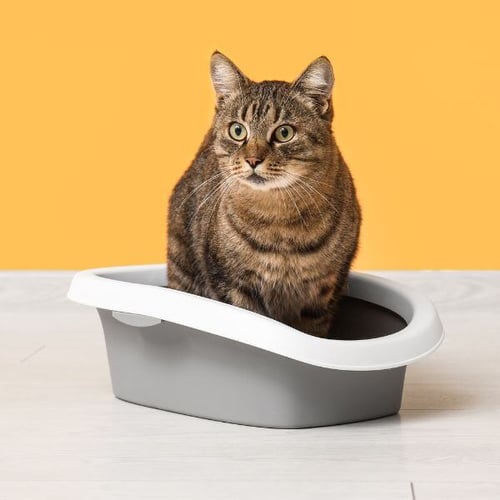
"My Cat Uses Their Small, Covered, Less-Than-Ideal Box Just Fine. Do I Still Need to Make Changes?"
That’s a tough one. If it’s not a problem for you to make changes, give it a shot. The more your cat’s environment fits their natural needs, the better their quality of life. So, why not?
Since you should have more than one litter box, try adding an optimal litter box as a choice.
If changing your cat's litter box setup would mean major issues for you, like having to squeeze multiple boxes into a small apartment, and your cat doesn’t have any behavior issues or signs of stress, maybe it’s not as important.
However, just because your cat has been using the same litter box setup for years doesn’t mean they like it.
Just like the proverbial straw that broke the camel’s back, if something changes (like the added stress of a new pet or baby, moving, or medical issues), that may be the moment your cat decides they can’t handle their litter box anymore. So, if you’re suddenly dealing with soiling issues, try litter box changes, even if they’ve been using that same setup successfully for years.
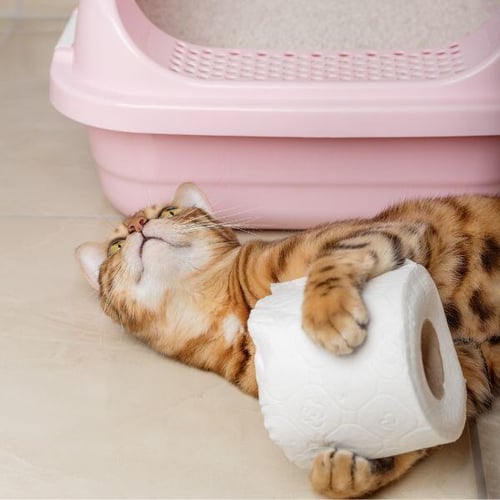
The Ideal Litter Box For Cats
Understanding that every home and situation is different, I’m going to walk you through how to choose the “best” litter box for your cat. In our Litter Box Setup article, we talk about the “ideal” setup, which is very important, too.
Don’t worry. We’ll also talk about how to make the best of what’s available and what you can tolerate.
We all have different places where we draw the line. For me, it’s a litter box in the kitchen or bathroom. That’s something I’m not comfortable with.
Having said that, there are situations where I’d be willing and eager to put a box in my kitchen or bathroom. If my cat was experiencing stress, having issues with another cat in my home, or peeing or pooping outside the box, I’d adjust my preferences to try and resolve the situation.
What I tell people is, “If doing this fixes the problem (whether, for example, it’s putting a box where you don’t want one or opting for an uncovered box when you prefer covered), would it be worth it?” If the answer is yes, give it a shot. If the answer is no, then try other solutions. For me, I’d rather have an open box where I don’t want one than have an anxious cat or one who’s peeing somewhere else. You’ll have your own boundaries and levels of flexibility depending on your situation.
If your cat isn’t having house soiling, stress, or problems with other pets in the home, you can be a bit more lax about what’s “ideal.”
Litter Box Guidelines
Measurements
Measurements are not always as simple as looking at the dimensions on the packaging of the box. Some commercial boxes include storage compartments on the end. The measurements on the box will include the compartment.
You’ll need to subtract the compartment length to get the measurement for the usable section of the box. That’s the space your cat can actually stand in – that needs to be 1½ times your cat's body length (or about as long as your cat, including most of their tail).
The box should also be wide enough that your cat can turn easily. A box should be at least 13–15 inches wide, depending on the size and age of your cat (senior cats may need more room to turn around).
If you’re doing a DIY option, consider the shape of the box. Some tubs or boxes are narrower at the bottom than the top. Some list the exterior measurements only. You want to look at the bottom, interior measurement.
See how to make a DIY litter box below.
Shape
Box shape can also be misleading. Corner boxes, for example, are large when you measure corner to corner. But what’s the real usable space for your cat? They aren’t likely to back into one of those corners. When you look at the space in the middle that your cat can easily use, it’s much smaller than the overall size of the box.
Unfortunately, we cannot find a commercially available corner litter box that is big enough.
Commercially Available Litter Boxes
One of the few commercial litter boxes I’ve found that’s large enough for my average-sized cat, who’s about 22 inches long (including his tail), is the ExquisiCat Compartment Litter Box.
I’ve been using the ExquisiCat for a few months, and I really like it. The material is strong, and it has a slick texture, making it easier to keep clean. It also includes a small compartment to store your litter scooper.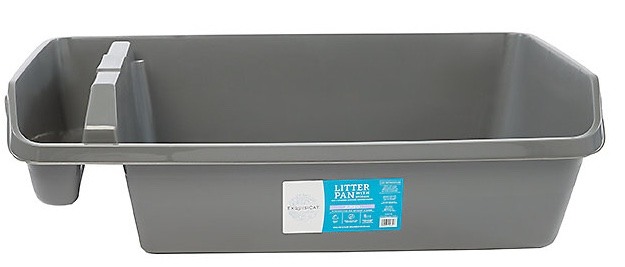
Senior and Limited-Mobility Litter Boxes
There may come a time when your cat can’t manage getting in and out of a regular litter box. It could be arthritis, knee issues, or a temporary medical issue. 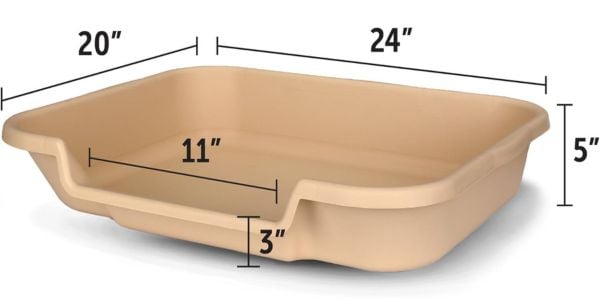
These specially designed boxes have low sides and very low, flat entrances so senior or sick kitties can walk right in and don’t have to worry about stepping or jumping in and out. The very low sides also make it easier to turn around while in the box.
Even a potting tray similar to this one could work with its wide, low side.
Making Your Own DIY Cat Litter Box
I often suggest people make their own litter box, especially if they have large cats.
The nice thing about making your own box is that you can tweak it to fit your cat’s needs. For example:
Two entry openings. It’s common for cats to step in the box and leave their backend hanging out the opening. Their “business” lands outside the box instead of inside. A larger box can help. As I mentioned earlier, senior kitties have a hard time turning inside the box. You can also try adding a second opening in the back and positioning the box so your cat can enter from one side, do their business, and then step right out through the other side.
Lower entry openings. The images of the box I made below in the high-sided DIY section have a slightly higher opening. As my senior cat got older and her mobility worse, I was able to make the opening to her boxes lower and wider so she could get in and out more easily.
Covered box. There are times when you may need a covered box. Perhaps you have respiratory issues and need to control litter dust. I’ve only come across a few cats who prefer a covered box, but it does happen. Or you may have a dog or toddler you need to keep out of the box. Making your own gives you the option to go much larger than you’ll find in commercial, covered boxes.
Look for a box large enough that your cat can squat without having to duck. It should also be clear so they can still see what’s happening outside the box even though it’s enclosed. And if you have issues with cats bothering and stalking each other in the box, you might want to try the two opening idea mentioned above, so it’s a little less like Whack-a-Mole. Lastly, you definitely want the entry opening on the side, not the top.
DIY Low-Sided Litter Box
If you want a low-sided option, an under-bed storage container works really well. They’re very long. You just take the lid off, and you have a litter box — and you can get them in multi-packs to save money!
To make an even lower entry for a senior or mobility-challenged cat, make a cutout on the narrower end of the container. Ideally, 2 inches off the ground. You can see the tools and process I used to do this below.
DIY High-Sided Litter Box
Many cats need high-sided boxes. I suggest them to people whom I’m encouraging to move away from covered or enclosed boxes. A box with high sides can feel more contained for you, making the transition feel a little less icky and the cleanup easier.
If you have a high pee-er, meaning they don’t do a full squat to pee, this option will keep the pee in the box where it belongs. This is a common problem for senior cats with arthritis because squatting can be painful.
High sides also keep more of the litter in the box, whether your cat goes overboard like mine and piles all the litter in one corner or likes to spring out of the box in full zoomies mode, taking half the litter with them.
Try a big storage bin like these Sterilite containers. If you have a larger cat, it’s easy to find larger versions.
-
Go with a clear storage bin. That way, even if it’s taller than your cat, they still have nice, open sightlines. They can see if anything is coming. If your cat is taller than the bin, then it doesn't need to be clear.
-
Do not use the lid so you have an open box.
-
Cut an opening in the side for easy access. This opening can be a bit higher if you need to keep litter in the box or a bit lower if you have kitties with mobility issues.
How to Cut an Opening in a Storage Bin Box
I’ve heard that people have issues with storage bins cracking or shattering when they try to cut the entry opening. I have a few tips:
-
I use a small handsaw like this one.
-
Use heavy tape, like duck tape.
-
Run a line of tape just outside the line you want to cut. This will help stabilize the plastic and keep it from cracking as you saw through it. It’s hard to see in the image above because the tape is white. The tape is just to the right of the saw blade.
It helps if you have two people — one to saw and one to put pressure on the plastic so it doesn’t flex as much as you’re cutting. But it can be done with one person.
Once you’ve cut your opening, you might want to sand the edges. I just put duct tape over the cut edges so they’re nice and smooth, as the edges can be very sharp.
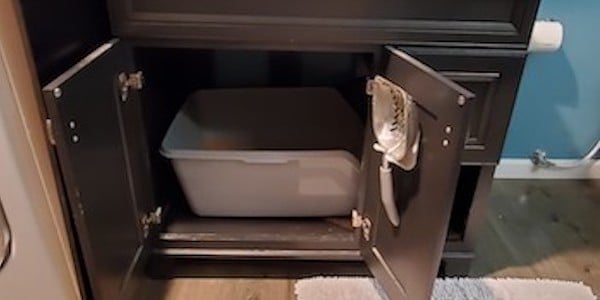
Can a Litter Box Enclosure Work for Cats?
They’re not ideal. But I know there are times when it’s necessary. If it’s the only way to get boxes where your cat needs them, give it a shot. Just be prepared to walk it back if you notice stress, cats bothering each other or stalking when one is in the enclosure, or house soiling.
Go as large as you can. Try to avoid small cabinets. Open whatever you can. Maybe there are double doors on the front, and you can leave one open or a flap over the entrance that you can remove. Make sure it’s not really dark inside the enclosure – use motion-controlled lighting. Cats can’t see well in heavy darkness and may avoid using it if they can’t see.
How Often Should You Replace Your Cat's Litter Box?
Whether you’re using a plastic commercial litter box or made one yourself from a storage tub or other plastic material, it will need to be replaced. There are differing opinions on how often.
How well you scoop and wash/disinfect it can also play a role. A good rule of thumb is to replace at least once a year. Look for scratches in the plastic or dried litter ick that are hard to remove. The scratches will hold bacteria and stink. If you’ve got ‘em, it’s time for a new box. You can learn more about litter box cleaning and controlling odor in this article.
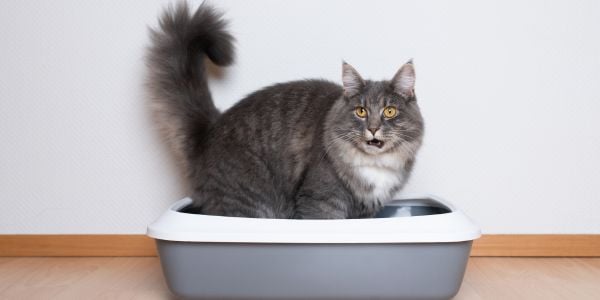
It shocks me that most commercial litter boxes do not meet the needs of cats, but at least you know what to look for now.
Next, it’s time to think about the other things that go into your cat’s litter box setup. We have an article on types of litter that you can check out next. And don’t miss our Setting Up Litter Boxes article to learn more about how many boxes are ideal, where to best position them, and even how to make daily scooping less of a chore.


